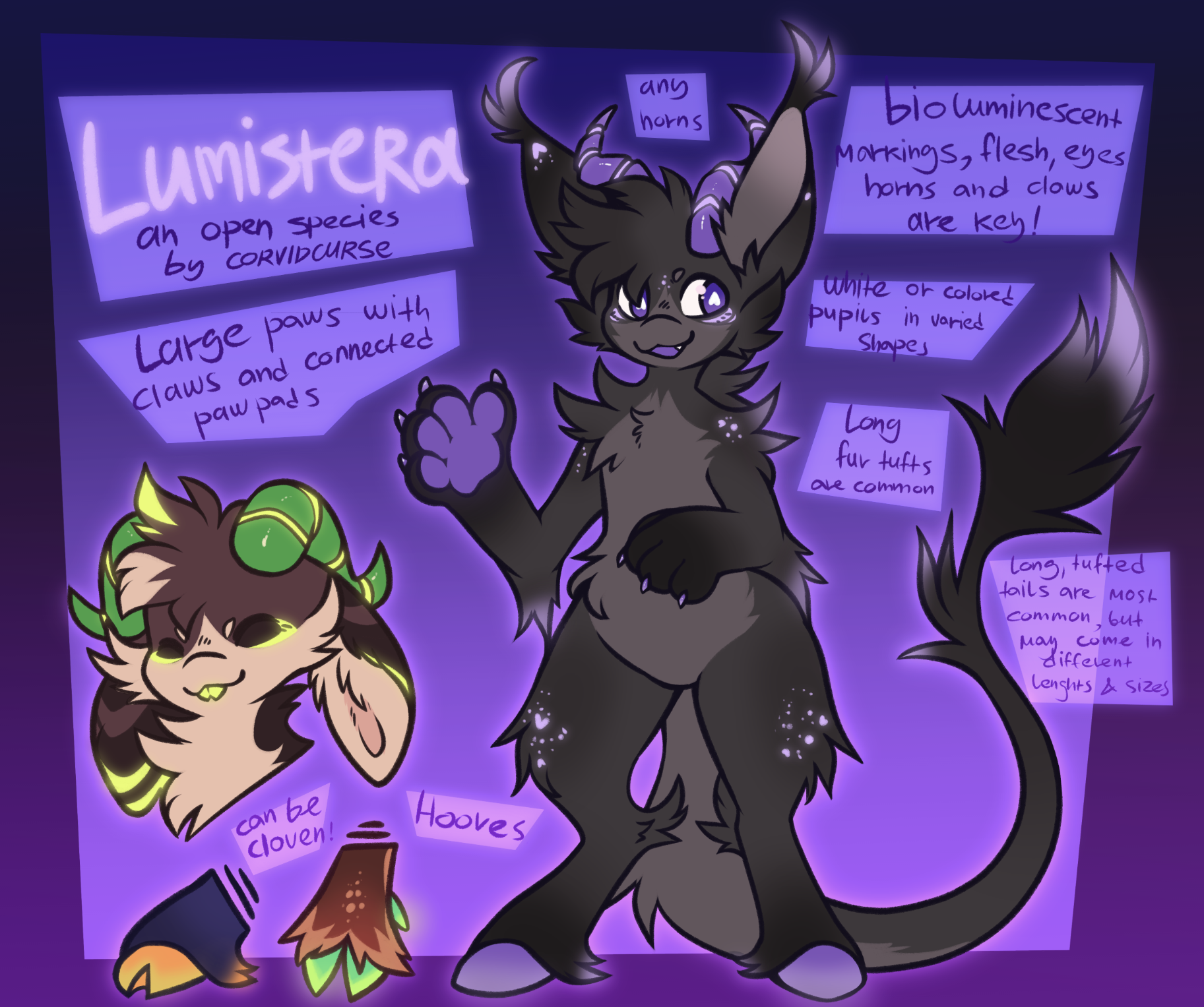LUMISTERA

Appearance & Physiology
Lumistera typically stand upright at an average height of 5’11”/1.65m, have forked tongues, large paws with non-retractable claws and one fused pad between the palm and fingers, their fur varies in length and they will commonly have longer tufts on areas of their body such as elbows, hocks, chests and back of the neck. They can have a variety of ears and tails, though it’s common for them to be a bit long.
Most notable feature of the lumistera is their bioluminescence, seen in their flesh, markings, horns/antlers and hooves. Most lumistera will possess some kind of bioluminescence, it’s rare for lumistera not to have any, but it can occur in lumistera born outside of their species’ glowing and shaded homelands, additionally lumistera that spend extended time in brighter environments may have their bioluminescence dim. In such cases if said lumistera spend time back in their homelands or consume food from them, their glow will return. They can also somewhat control their glow, making it dim at will, though this takes conscious effort, so they don’t do it very often.
Second notable part of lumistera is their horns and hooves. While some may lack horns, non-hybrid lumistera are not seen without hooves without body modification. Lumistera horns come in all shapes and sizes, while as previously mentioned they may lack them entirely, having a good set of horns is a point of pride for lumistera. They can shed and regrow their horns occasionally, but don’t usually do so regularly.
Magic Ability
Lumistera have an affinity for light magic, this primarily manifests in how they control their bioluminescence, being able to dim it at will (often using this to “disappear” in darkness), and even moving the glowing markings across their body, or changing the color of their glow. Lumistera who are skilled at this ability can put on whole light shows with just their bodies.
They can manifest lights too, but they don’t usually do so as they favor darkness, but they will sometimes make glowing “paint” for marking and decoration, they usually paint using their claws and paws, but if they possess long tails, they will sometimes use them too if they have enough control of them.
Life / Society
Lumistera tend to be fairly reclusive, not being often seen by others nor outside their homelands. They thrive in shaded and dark environments and feel exposed and uncomfortable in fully lit areas, which contributes to their secrecy.
If they spend an extended amount of time outside of their home environment they can get used to higher light, but will typically still mainly be out at darker times of the day.
Hybrids and lumistera born outside their home biomes are typically less affected by this, but they are still somewhat attracted to darkness.
They usually tend to live either alone or in small tight knit groups, it’s not uncommon for them to bond with some smaller local fauna for company as well. They rarely live in other species’ settlements, although “outsider” lumis and hybrids will do this more commonly.
As stated previously, due to their nature they rarely step outside of their home environment, most other species don’t often see them, most common experience with lumistera is seeing a flash of glowing eyes and spots or stripes in darkness.
When they have more proper encounters, they tend to be fairly awkward and standoffish, having a harder time communicating with others due to having developed a slightly different dialect living separately. This leads to them having a reputation for being intimidating and weird.
Due to living in similar areas and having differing opinions about light, they tend to get into conflict with luceaptera, where lumis love their darkness, the moths love bright lights and lighting up dark areas. This leads to territorial disputes and to lumistera often having negative attitudes towards luceaptera, from being avoidant to aggressive to them.